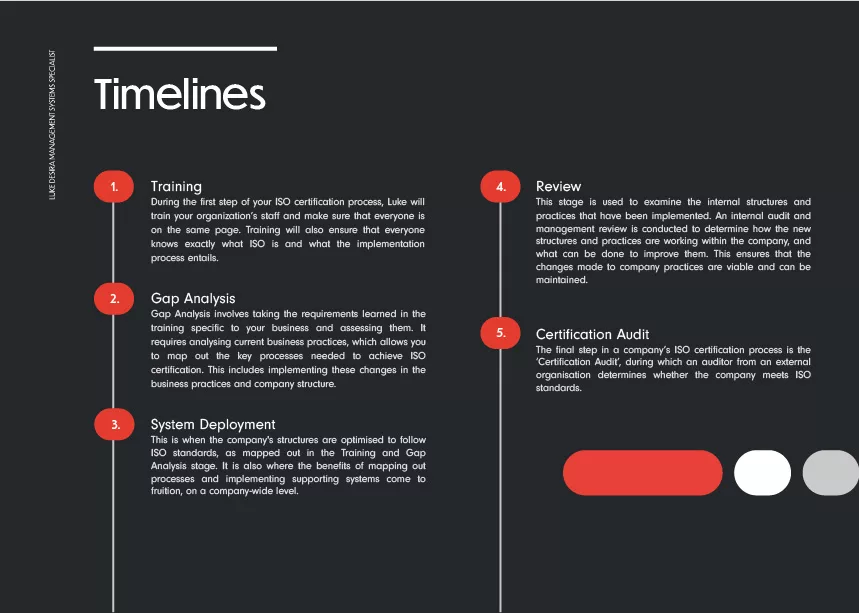Content
- What is ISO certification?
- How to get ISO certified? The road to continuous improvement…
- How to get ISO certified as soon as possible?
- Which is the best ISO certification?
- Eager to learn more about how to become ISO certified?
The key to demonstrating a company’s commitment to quality management and towards reaching business goals are the infamous ISO standards. These standards provide an organisation with a highly recognised certification or accreditation that are bound to open many opportunities in the future.
With that being said, if you are interested in becoming ISO certified, the route on how to get ISO certified may not always be clear. So, without further ado, let us tackle the most common questions surrounding the topic: how to become ISO compliant.
What is ISO certification?
Chances are you already know, but if you don’t, then don’t worry. The very first step you must take in becoming ISO certified is to understand what ISO certification is. ISO certification follows a 10 clause process that assesses a company’s management system against an ISO standard. Each ISO standard outlines how a company should act to have an optimal management system in place. Each ISO standard focuses on various aspects of an organisation, be it quality (9001), information security (27001) or environmental (14001).
Essentially, for you to attain ISO Certification, you would need to undergo a robust exercise that sets up efficient procedures and quality checks across the running of your business operations. This is done to ensure your business operates efficiently, with a focus on maintaining quality standards in the way you work.
Certification or accreditation is awarded upon succeeding in the assessment of an independent external auditor. Having ownership of an ISO certification or accreditation means that the organisation in question is compliant with the ISO standard and for this effort, the organisation gets a globally recognised document.
The question “What is ISO certification” is commonly followed by an additional question: “Why should my organisation become ISO compliant?”
Getting ISO certification is more than simply achieving an international accreditation. It signals that your business maintains a high-level of quality and is a leader within its industry. In fact, the benefits of ISO reach far beyond your system of operations and will inevitably seep into each aspect of your business, including marketing and retail, employee commitment and strategic planning.
As your company increases its level of efficiency and competency, your brand’s reputation will increase and earn a new found respect from stakeholders and competitors all over the world. Besides lending your company credibility, well-structured ISO systems will help your company lower its over-all costs, achieve a level of sustainability and consistently deliver a good quality service. Each ISO standard holds its own set of benefits, but all of them are designed to improve the working industries’s standards of excellence.
If you would like to read more about the benefits that tag along with ISO certification, do read this article: UNCOVER THE BENEFITS OF ISO 9001 CERTIFICATION
How to get ISO certified? The road to continuous improvement…
The process surrounding the million dollar question on how to get ISO certified can be said to be split in 5 steps. The process to obtain and retain ISO certification with Luke Desira can be split as follows:
- Training
- Gap Analysis
- Systems Development
- Review
- Certification Audit

Step 1 | Training
In the first step of your ISO certification journey, Luke will conduct comprehensive training sessions for your organisation’s staff. Your employees will be given the necessary knowledge to understand ISO standards and the skills needed to excel in an ISO-certified environment.
Through interactive and engaging training sessions, Luke will explain the step by step process of how to get ISO certified and will equip all employees with the understanding of why Sio is vital for a business organisation. Luke will break down all complexities surrounding ISO and ensure that your team gets the grips with the framework of ISO standards and the benefits of being ISO compliant.
The training session will also be the space where Luke will be able to foster a culture of continuous improvement within your organisation. Every team member will clearly be able to understand their role in your organisation and their importance in relation to the ISO framework. With Luke’s expertise and guidance, your organisation’s staff will be well-prepared and empowered for the rest of your ISO certification journey.
Step 2 | Gap Analysis
Gap Analysis, a crucial step in the ISO certification process, goes beyond just training by leveraging the requirements learned and tailoring them to your unique business context. With meticulous attention to detail, Luke shall thoroughly assess your current business practices, comparing them against the ISO standards.
This comprehensive analysis identifies gaps between your current practices and the requirements of ISO certification. This process provides a clear roadmap for achieving compliance, as it highlights the areas that need improvement and allows Luke to map out the key processes necessary to bridge the gaps and successfully chip away at the question, “How to become ISO certified?”
Luke will work closely with your organisation to implement these changes, aligning your business practices and company structure with the stringent ISO standards. This involves developing practical solutions and strategies tailored to your organisation’s needs, ensuring the changes are practical and feasible for your unique operations.
Step 3 | Systems Development
This is when your company’s structures are strategically fine-tuned to fully align with the ISO standards, as previously mapped out in the Training and Gap Analysis stages. This critical phase involves implementing changes to your company’s operations, policies, and procedures to ensure compliance with ISO requirements.
Building upon the insights gained from the previous stages, Luke will work closely with your organisation to optimise your business processes and systems. This includes streamlining workflows, establishing clear guidelines, and developing effective controls to ensure that ISO standards are seamlessly integrated into your company’s operations.
The benefits of the meticulous process mapping and system implementation efforts become evident at a company-wide level. Your organisation will experience improved operational efficiency, enhanced quality control, and increased consistency in processes throughout the organisation. Employees at all levels will be empowered with the necessary knowledge and skills to adhere to ISO standards, resulting in a culture of quality consciousness and a shared commitment to excellence.
Overall, this stage is a pivotal milestone in the ISO certification journey, as it signifies the successful integration of ISO standards into your company’s structures and processes. It sets the stage for a seamless certification audit. It positions your organisation for long-term success by reaping the benefits of improved processes, increased efficiency, and a culture of quality excellence.
Step 4 | Review
The fourth stage is a critical step in the ISO certification process, where the internal structures are carefully examined. Luke will conduct a comprehensive internal audit and management review to assess your company’s new systems and practices and their effectiveness.
During the internal audit, Luke shall verify that all changes that have been implemented are being followed consistently, identifying any deviations or non-conformities, and seeing that corrective and preventive actions are following through..
Based on the internal audit and management review findings, Luke shall provide recommendations to refine the process, enhance controls, and address any non-conformities to ensure ongoing compliance with ISO requirements.
The primary goal of this stage is to ensure that the changes made to your company’s practices are viable and can be sustained in the long term. By reaching this stage, you will have edged closer than ever before to the answer of the question, “How to become ISO certified?”
Step 5 | Certification Audit
The final step in a company’s ISO certification process is the ‘Certification Audit’, during which an auditor from an external organisation determines whether the company meets ISO standards. This audit is a comprehensive assessment of your company’s compliance with the ISO standards.
During this audit, an external auditor reviews your company’s processes, procedures, and documentation to verify whether or not they align with the requirements of the applicable ISO standard. Here, the effectiveness of your quality management system is evaluated and put to test,
Upon successfully completing the Certification Audit, your company will be awarded the ISO certification, which serves as a formal recognition that your organisation has met the requirements of the ISO standards. The ISO certification demonstrates your company’s commitment to quality, customer satisfaction, and continuous improvement, and it can enhance your organisation’s reputation, competitiveness, and business opportunities.
It’s important to note that the Certification Audit is not a one-time event but an ongoing process. Once certified, your company will be subject to periodic surveillance audits by the external auditor to ensure continuous compliance with the ISO standards. These surveillance audits are typically conducted annually or as per the requirements of the specific ISO standard. Hence, fostering a culture of continuous improvement is a must-have for any ISO-certified company.
If you’ve reached this stage, you deserve a big pat on the back! Well done!
How to get ISO certified as soon as possible?
The process surrounding the million dollar question “How to get ISO certified” generally takes around 6 months to complete. However, no organisation is the same and sometimes, different situations may require different approaches. Luke has had clients where Iso certification was obtained in less than 2 months and he also had clients where they became ISO certified after 12 months.
The reality is that ISO certification can be attained through just 36 hours of consultancy. However, this depends on how big the organisation is (which dictates how many people are to be trained) and the time which the management has allocated to the project of ISO implementation.
This may be a no-brainer, but do keep in mind that not allocating enough time and resources towards this project be destructive. So when diving into such a project, ensure that your organisation is well prepared and ready to take on the journey of how to become ISO certified.
Which is the best ISO certification?
There are various’ management systems issued by the ISO, including ISO 9001 for quality management, ISO 14001 for environmental management, ISO 45001 for occupational health and safety, and ISO 27001 for information security management. Evidently, each management system caters for different needs, therefore the best ISO certification depends on your business’ needs. That said, ISO 9001 is the foundation of all other management systems and the best one to start with.
If you want a more comprehensive view of which ISO standard is best suited for your industry, click to learn more!
ISO 9001 – the process of quality management
To answer your question on how to become ISO 9001 certified, just know that this certification follows the same eight steps listed above. ISO 9001, like all the other ISO standards, follow the 10-clause structure that will help an organisation, irrespective of its size, to offer excellent value in driving efficiency and upscale as necessary while retaining a high level of quality.
Becoming ISO 9001 certified will enable your organisation to enjoy great benefits, including better brand reputation, increased customer satisfaction and even better management. If you are thinking on how to become ISO 9001 certified, have a look at what Luke Desira has to say about Risk Management in ISO 9001, or even better, read this article on Understanding Corrective and Preventive Actions in ISO 9001.
ISO 27001 – the process of information security
In today’s digital world., information security has become a necessity, not a luxury. Every company that handles sensitive information is responsible for securing the information it has been entrusted with. Not only does this prevent avoidable data breaches but, having these procedures in place, can also benefit the day-to-day running of the organisation. In fact, ISO 27001 is designed to help businesses run more smoothly and efficiently, whilst protecting customers from the possibility of data breach.
The answer on how to become ISO 27001 certified follows the exact same structure of ISO 9001 – there are 10 clauses and all the steps mentioned above must be satisfied. Remember, ISO 27001 certification shows that your organisation values the importance of safeguarding sensitive and confidential data, and is committed to preventing data breaches and cyber attacks. Don’t neglect your organisation’s digital aspect; learn how to become ISO 27001 certified with Luke.
EAGER TO LEARN MORE ABOUT How to become ISO certified?
As an ISO management system consultant Luke Desira will make it his personal mission to put your company on a class above all others! Make sure to follow Luke’s advise and avoid these 10 pitfalls when implementing an ISO management system.
All management systems based on ISO Standards that are implemented should pertain directly to the organization’s objectives. This may be an easy stumbling block if you are unaware. Have a look at the ISO Certification specialised by Industry to understand which ISO certifications and accreditations your organization can benefit from.
Luke offers a variety of ISO certification services that puts him as the leading ISO Certification consultant in Malta. He can efficiently help you achieve ISO accreditation. When ready, just call Luke Desira – he’ll be waiting to provide a helping hand.
Don’t forget to follow us on our Facebook and LinkedIn profiles, and subscribe to our Youtube Channel for more great content.








